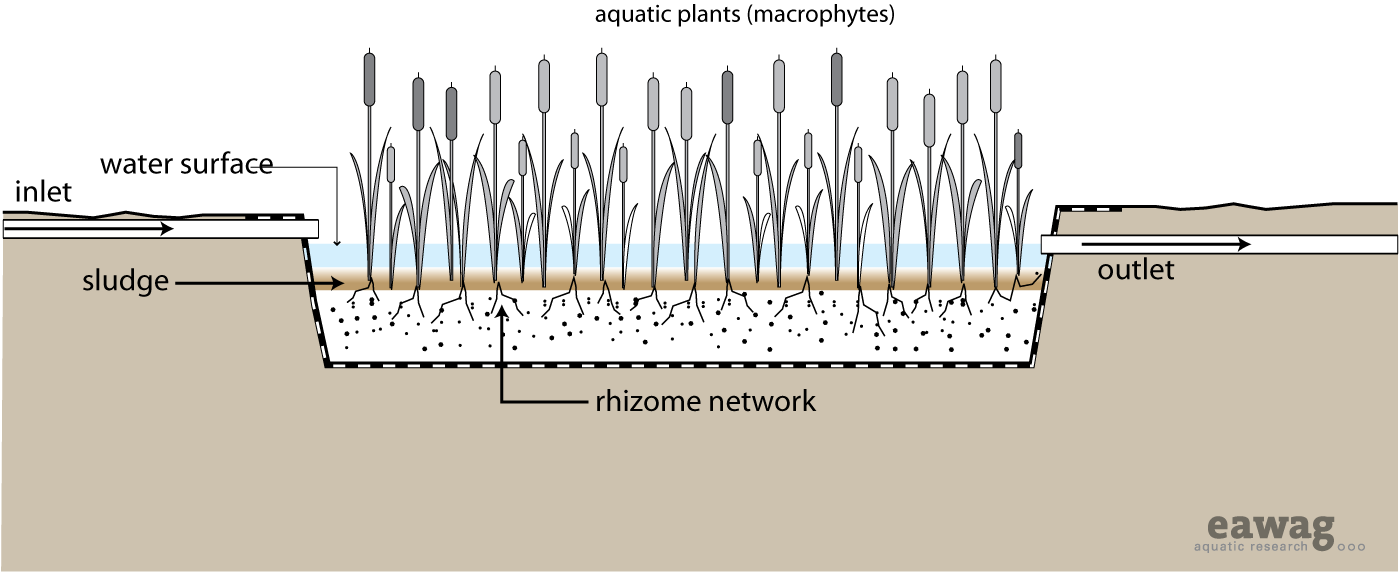Free-Water Surface Constructed Wetland
|

|
|
| |||||||||||||||||||||||||||||||
A Free-Water Surface Constructed Wetland is a series of flooded channels that aims to replicate the naturally occurring processes of a natural wetland,marsh or swamp. As water slowly flows through the wetland, particles settle, pathogens are destroyed, and organisms and plants utilize the nutrients.
Unlike Horizontal Subsurface Flow Constructed Wetland, the Free-Water Surface Constructed Wetland allows water to flow above ground, exposed to the atmosphere and direct sunlight. The channel or basin is lined with an impermeable barrier (clay or geotextile) covered with rocks, gravel and soil and planted with native vegetation (e.g. cattails, reeds and/or rushes). The wetland is flooded with wastewater to a depth of 10 to 45cm above ground level. As the water slowly flows through the wetland, simultaneous physical, chemical and biological processes filter solids, degrade organics and remove nutrients from the wastewater.
Raw blackwater should be pretreated to prevent the excess accumulation of solids and garbage. Once in the pond, the heavier sediment particles settle out, also removing nutrients that are attached to particles. Plants, and the communities of microorganisms that they support (on the stems and roots), take up nutrients like nitrogen and phosphorus. Chemical reactions may cause other elements to precipitate out of the wastewater. Pathogens are removed from the water by natural decay, predation from higher organisms, sedimentation and UV irradiation.
Although the soil layer below the water is anaerobic, the plant roots exude (release) oxygen into the area immediately surrounding the root hairs, thus creating an environment for complex biological and chemical activity.
The efficiency of the Free-Water Surface Constructed Wetland also depends on how well the water is distributed at the inlet. Wastewater can be input to the wetland using weirs or by drilling holes in a distribution pipe to allow it to enter in even spaced intervals.
| Advantages | Disadvantages/limitations |
|---|---|
| - Aesthetically pleasing and provides animal habitat. - High reduction in BOD and solids; moderate pathogen removal. - Can be built and repaired with locally available materials. - Construction can provide short-term employment to local labourers. - No electrical energy required. - No real problems with flies or odours if used correctly. |
- May facilitate mosquito breeding. - Long start up time to work at full capacity. - Requires large land area. - Requires expert design and supervision. - Moderate capital cost depending on land, liner, etc.; low operating costs. |
Adequacy
Free-Water Surface Constructed Wetlands can achieve high removals of suspended solids and moderate removal of pathogens, nutrients and other pollutants such as heavy metals. Shade from plants and protection from wind mixing limit the dissolved oxygen in the water, therefore, this technology is only appropriate for low strength wastewater. Usually this requires that Free-Water Surface Constructed Wetlands are only appropriate when they follow some type of primary treatment to lower the BOD.
Depending on the volume of water, and therefore the size, wetlands can be appropriate for small sections of urban areas or more appropriate for peri-urban and rural communities. This is a good treatment technology for communities that have a primary treatment facility (e.g. Septic Tank). Where land is cheap and available, it is a good option as long as the community is organized enough to thoroughly plan and maintain the wetland for the duration of its life.
This technology is best suited to warm climates but can be designed to tolerate some freezing and periods of low biological activity.
Health Aspects/Acceptance
The open surface can act as a potential breeding ground for mosquitoes. However, good design and maintenance can prevent this.
The Free-Water Surface Constructed Wetlands are generally aesthetically pleasing, especially when they are integrated into pre-existing natural areas. Care should be taken to prevent people from coming in contact with the effluent because of the potential for disease transmission and the risk of drowning in deeper waters.
Maintenance
Regular maintenance should ensure that water is not short-circuiting, or backing up because of fallen branches, garbage, or beaver dams blocking the wetland outlet. Vegetation may have to be cut back or thinned out periodically.
References
- Elizabeth Tilley et.al (2008). Compendium of Sanitation Systems and Technologies (low res version). Department of Water and Sanitation in Development Countries (Sandec) at the Swiss Federal Institute of Aquatic Science and Technology (Eawag). (Provides a full overview of sanitation systems.)
- Crites, R. and Tchobanoglous, G. (1998). Small and Decentralized Wastewater Management Systems. WCB and McGraw-Hill, New York, USA. pp 582–599. (Comprehensive summary chapter including solved problems.)
- Mara, DD. (2003). Domestic wastewater treatment in developing countries. Earthscan, London, UK. pp 85–187.
- Poh-Eng, L. and Polprasert, C. (1998). Constructed Wetlands for Wastewater Treatment and Resource Recovery. Environmental Sanitation Information Center, AIT, Bangkok, Thailand.
- Polprasert, C., et al. (2001). Wastewater Treatment II, Natural Systems for Wastewater Management. IHE Delft, The Netherlands. Chapter 6.
- QLD DNR (2000). Guidelines for using free water surface constructed wetlands to treat municipal sewage. Queensland Government, Department of Natural Resources, Brisbane, Australia. Available: http://www.epa.qld.gov.au
